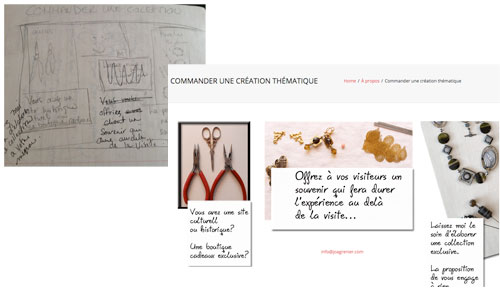by Mélanie L. Sisley
The competition for quality is fierce out there. But perhaps the very answer to quality is dependent on our sloppy, creatively unguarded side. Just imagine what could happen if we let the unfinished, unpolished ideas come out without fear of judgment or ridicule.

Paper prototype transformed into screen
Study shows the quality effect
In his course Human Centred Design, Dr. Scott Klemmer’s (UC San Diego) explores this very question. He presents a study done by Bales and Orlando (2001) wherein a local pottery class receives the following challenge: half the class is to produce as many items as they can and would be graded on quantity no matter how good the pieces. The other half of the class is told they would be graded on quality of the very best thing they made.
What they found is that the group who focused on quantity churned out many different objects, learnt from their mistakes, produced alternatives and in turn the quality improved significantly as the day wore on (an unintentional yet welcome side effect). The group that focused on quality spent most of their time theorizing and had little to show at the end of the day.
Turn ideas into prototypes
I appreciated this story because as a designer I was always told to be systematic to get impactful results. First collect needs data, look for gaps, set objectives and then, only then, come up with a design. I was told to slow down, ask lots of questions and not assume too much.
Of course, there is nothing wrong with that method – except it didn’t work for me.
When I had a consultation with a new client, my ideas would bubble up so quickly I didn’t know where to start. So I would sneak away and build what I called a “quickie-prototype” — just for fun.
Turns out my quantity-driven process made it much easier to prompt a discussion and figure out the right direction for the project. It was also easier on the client, who was previously in the hot seat with my million questions.

Interface prototype done in Power Point
Focus on ideas – not the ego
Of course, this is not entirely news to those of us working in the rich media and computer science fields. It is the basis for the current trends of “rapid prototyping” and “agile” computing. Spending too much time on delineating objectives and learning outcomes and/or usability needs can be tedious and sometimes feel like performing surgery with boxing gloves.
The rapid prototype can be a great way to throw up ideas and generate a more pointed and purposeful reflection of just what needs to be achieved.
Moreover, Dr. Scott Klemmer points out that creating several prototypes helps the designer detach the ego from the ideas. In other words, when several models are presented, the feedback becomes focused on the ideas rather than the person who designed them.
Rapid prototyping gets to the truth
Prototyping is a great way to observe user interaction. Klemmer points out that there is sometimes a significant and even contradictory gap between what users say they want and what they actually want.
He cites a marketing survey done by Walmart, where customers were asked if they would prefer less clutter in the stores. The answer was almost unanimously yes. But when Walmart put this feedback into practice, sales actually went down. The point is, prototyping is a great way to observe behavior as well as ideas, which can in turn provide very poignant data to create a truly great solution.
So let’s embrace our fiercely unguarded creative side and let’s churn out those designs!
After all, a good design shouldn’t be about the designer, but about the user. And nailing what has impact and meaning to the user is what this process is all about.
https://www.youtube.com/watch?v=p_KUjZCl4T8
Video prototype of an ebook

